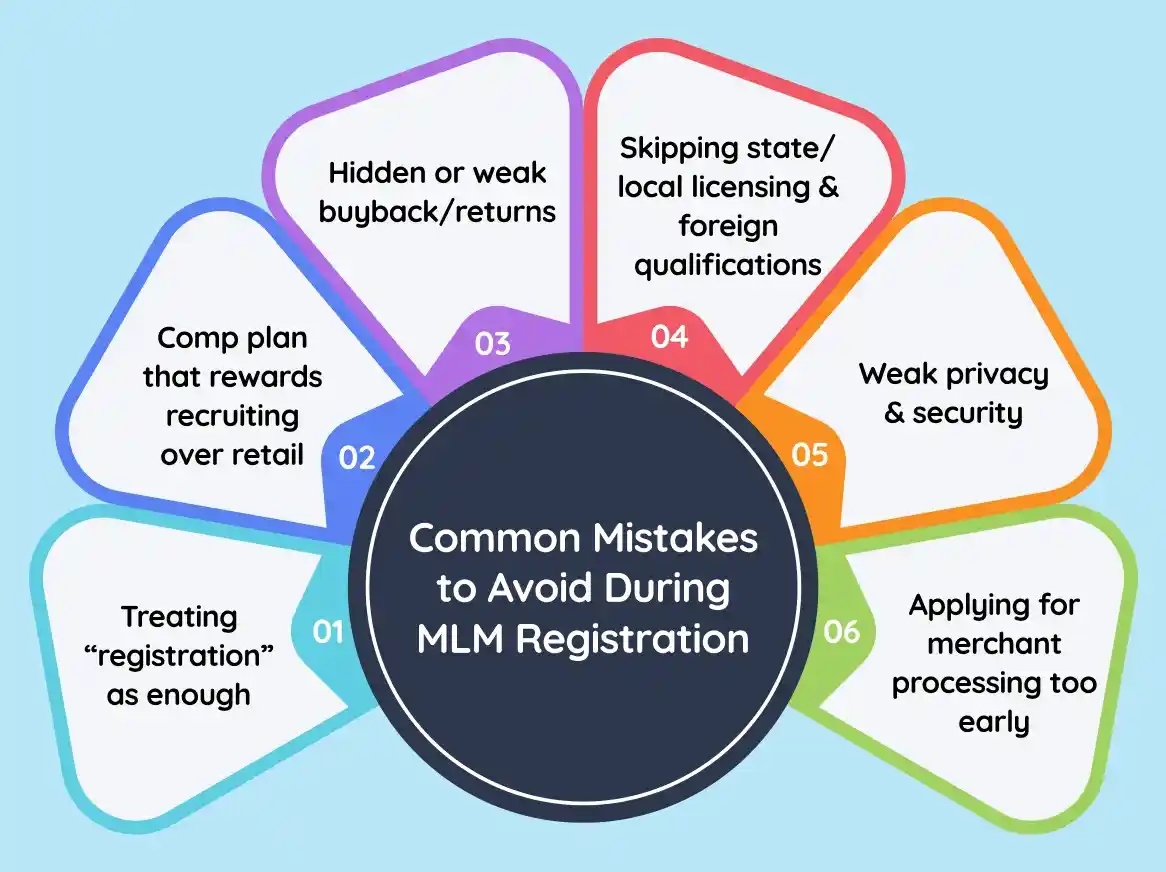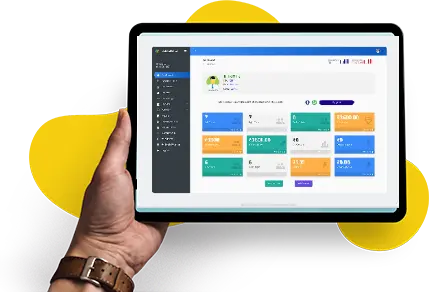There are more than a thousand legitimate MLM companies in the United States, and each one has gone through a proper MLM registration process. Starting a direct selling business in the U.S. involves much more than forming an LLC.
You’ll have to go through entity filing, compliance with multi-state rules, and implementing data security controls. While every company needs to do the same, there are specific aspects that are only applicable to direct selling businesses.
Our MLM registration process guide will help you get ready before you initiate the process and take you through each direct selling registration step. We will also explain to you the compliance and regulatory requirements that you need to fulfill to begin your MLM compliance journey.
This Article Contains:
What is an MLM Business Registration Process?
The MLM registration process refers to the end-to-end sequence of forming a legal company in the direct selling domain, where the company sells its products directly to customers as well as through distributors and their respective downlines.
There are two parallel tracks when you form an MLM company. First, there’s a general registration process that every company needs to follow, and then there are MLM-specific requirements.
1) General Business Registration Requirements
Choose the legal structure (LLC or C-Corp) and form the entity.
Obtain an Employer Identification Number and open bank accounts.
Get a state or local business license wherever required.
Set up federal/state tax accounts.
2) MLM-Specific Requirements
Draft and adopt a retail-first compensation plan that is compliant with anti-pyramid scheme laws.
Comply with the Federal Trade Commission guidelines before getting started.
Note: There is no specific federal “MLM license.” You only need to complete standard business registration while ensuring you fulfill direct-selling rules and consumer-protection expectations as per:
The states in which you operate
Your product category
Prerequisites Before Starting an MLM Business Registration
You must fulfill the prerequisites before starting an MLM business registration, as required by regulators, banks, and partners. Doing so shortens the direct selling registration timeline, lowers merchant-processing risk, and reduces rework requirements.
It also ensures that your business complies with MLM laws, is well-prepared to withstand competition, and undergoes a smooth network marketing registration process.
Define the Business Model: Product-Based Vs. Service-Based MLM
Decide whether you want to sell products or services and the category they belong to:
Products include physical goods such as cosmetics, health supplements, and home care items. For the selected products, ensure the proper labelling, define warranties, refund policy, and document product claims. Some products, such as healthcare products and food items, need additional licenses from their respective governing authorities. There can be additional compliance requirements, too. For instance, if the selling of products requires you to deal with Protected Health Information (PHI), HIPAA compliance is necessary.
Services-based MLM businesses include selling digital subscriptions, education, and digital bundles. Similar to product-based offerings, some service-based direct selling businesses also have additional compliance needs. For instance, if you are planning to sell insurance products, your distributors must have an insurance agent license, and you need to comply with additional state laws governing insurance sales.
Develop product/service catalog, decide on pricing and margins, create refund and buyback policy, and produce research for the claims.
Research Market Demand and Competition Analytics
Even before you start working on developing the product or service, make sure that it has real demand in the market. Doing so will help you avoid getting into MLM products that don’t perform well and save you from making the wrong investment. So, what should research and analytics include:
Segment Behavior: demographics, willingness to pay, seasonality of the product, and substitutes.
Competitor Teardown: Pricing, USPs, compensation plan, ranks and bonuses, refund rates, and complaints and public image.
Unit Economics: Customer acquisition cost, target retail ratio, gross margin after paying commissions, and refund/chargeback assumptions.
Based on the information, smartly price your products, create a competitive compensation plan, and implement strategies to minimize refunds and chargebacks.
Creating an MLM Compensation Plan
Creating an MLM compensation plan deserves specific mention. You must design a retail-first compensation plan that is compliant with anti-pyramid scheme laws.
Structure: Decide whether you want to move forward with a unilevel, binary, or matrix model. Define commissions, rank qualifications, and bonuses as well.
Compliance Features: Mention earning claims, payout conditions, and recruitment policies.
Transparency: Be clear regarding what you mention. There must not be any wordplay, even if it’s not intentional.
Preparing the Documents for Your MLM Business
Assemble the legal and operational documents that partners and authorities may ask for.
Customer and Distributor Facing Documents: Policies and procedures, distributor's agreement, income disclosure document, return policy, claims and advertising guidelines, privacy policy, and terms of use.
Onboarding and Training Material: It must contain guidance for distributors regarding claims they can make, compliance efforts required, and ethical recruitment practices they must follow.
General Business Registration Documents: Articles of Organization, Operating Agreement, Initial Consents, EIN letter, registered agent agreement, Certificate of Good Standing, and a few other documents that we will discuss in detail while going through the step-by-step process.
Defining the Legal Structure of the Company
Defining the legal structure includes whether you want to start with an LLC or a C-Corp. Many MLM businesses start with an LLC and convert to C-Corp when fundraising.
Also, you need to decide the state where you want to register your MLM business. For instance, if your target market is located in one particular state, you can choose the state for direct selling registration. However, to operate in other states, you need to get a foreign qualification certificate by registering there.
For instance, you form in Delaware, keep inventory in Texas, and hire a customer-support rep in Florida. You likely need a foreign qualification in Texas and Florida, plus their business licenses and tax accounts.
Step-by-Step MLM Business Registration Process in the U.S.

Step 1: Business Formation
Pick an entity type: LLC or C-Corp.
Choose the state in which you want to start the company.
Select the name and run a check with the United States Patent and Trademark Office.
Check the domain availability and social checks.
File Articles of Organization/Incorporation with the help of a registered agent.
Write and get formal approval for your company’s internal rulebook, i.e., prepare Operating Agreement/bylaws.
Issue Founder Equity along with an IP agreement, where all founders transfer the intellectual property rights to the company.
Decide where you want to do business and obtain foreign qualifications accordingly.
Step 2: Obtain EIN
An EIN or Employer Identification Number is a federal tax ID issued by the Internal Revenue Service, the US federal agency that administers and enforces tax laws. Banks, payment processors, and other partners use the EIN to verify your company.
So, how to obtain an EIN number?
If you have a Social Security Number or a Taxpayer Identification Number, you can simply apply online for your MLM legal registration process. After you fill out the IRS’s EIN application, you’ll receive the EIN immediately and can download the confirmation.
If you don’t have a Social Security Number or a Taxpayer Identification Number, i.e., you are a foreign founder, you need to file Form SS-4 by mail or fax. After that, you’ll receive an EIN in the reply after the IRS’s approval.
You’ll receive CP 575, which is the IRS EIN assignment notice, the first letter the IRS issues right after approval of your EIN application. You need to keep it safe, as banks, processors, and other partners will request it while you deal with them.
Step 3: Get State Business Licenses & Permits
It is one of the crucial MLM registration steps, which is about making your company operations legal wherever you do business in the United States. In the US, company formation isn’t enough. You need to get a license for specific states and cities where you are going to do business. Besides that, category-specific permits are also required.
So, after you get your EIN, the next step is to grab the required licensing so that you can do business while staying compliant.
General Business License: You need to take this basic license to conduct business activities. After obtaining it, you also need to apply for state-specific licenses, but that’s not the case with every state. Some states allow operations with a general business license. You’ll need to give information, such as exact legal name, EIN, industry description, business address, ownership info, and start date, estimated revenue. You can file your application with the US Small Business Administration.
Category and Location Permits: If you and your employees work from their residence in a city that regulates home occupation, you’ll need a permit for that. Besides that, if the business requires storage facilities, you need warehouse/occupancy/fire permits. If your MLM business is working in healthcare, consumable products, and beauty items, you need to check for specific local/state permits required. Some of the products require pre-approval from the Food and Drug Administration.
If you have pop-up events/home parties inside a particular city, check whether a temporary vendor or solicitor permit is required.
Step 4: Fulfill Federal & State Compliance
This step covers the complete compliance requirements that you need to fulfill while forming your MLM company.
a) Core Corporate & Filings
As we covered in the previous steps, keep a good-standing certificate and foreign qualifications for every state ready.
File Beneficial Ownership Information with the Financial Crimes Enforcement Network. It should be done within thirty days after you get it.
b) Tax Compliance (Sales/Use, Payroll, Information Reporting)
Map product taxability for supplements, cosmetics, and digital products, shipping costs, and discounts.
Document tax-exempt products, or if your MLM includes resale options.
Set up federal IDs if you have W-2 employees.
You need to get a Form W-9 for each distributor before making the first payout to the distributor. If a W-9 is not submitted, you need to collect withholding tax.
c) MLM-Specific Program Controls
Publish compensation plan, distributor agreement, product claims information, side effects or warnings, scientific proof of the claims, and certificates from governing authorities.
Join the US Direct Selling Association as a pending member and become a permanent member after the observation period ends.
Follow the FTC’s guidelines for creating a return and buyback policy, ensuring inclusion of MLM-specific requirements.
Prepare training sessions even before you onboard MLM distributors.
Publicly mention the income disclosure methodology.
d) Advertising, Marketing & Consumer Protection
Create marketing material aligning with product claims and features, allowing distributors to promote products/services using approved material only.
Add disclaimers wherever required, and they should not be contradictory to product claims.
Implement auto-renewal options in your system that comply with federal laws.
Introduce a consent management system before communicating and sending emails.
Implement consent management and Do-Not-Contact mechanisms before outreach.
e) Privacy & Data Security
Publish a privacy policy on the website and request consent from the visitor, distributor, and customers to agree to the privacy policy.
Set controlled access and multi-factor authentication across the business operations, applications, and databases before getting started to avoid unnecessary data sharing after the business starts functioning.
Comply with US privacy laws and state-specific laws. If your MLM business deals with customers and distributors from other countries, you need to ensure compliance with the privacy laws of those countries, too. For instance, compliance with the General Data Protection Regulation applies to countries in the European Union.
Before sharing data with vendors, conduct due diligence on their data security and ensure that their security standards are up to the mark. If you identify vulnerabilities, request that they close the loopholes before you share data.
f) Payments, PCI & Treasury
Complete merchant underwriting with your compliance packet (plan, policies, IDP, refunds, chargeback playbook).
Ensure PCI DSS compliance by implementing tokenization and hosted files. Ensure that card details are entered on processor’s interface, avoiding your interaction completely.
Define refund service level agreement and chargeback representation.
Configure payout processing for distributors’ commissions.
Set up a reconciliation system to ensure correct payment is made to distributors.
g) Product & Labeling (if product-based)
MLM Product labeling should identify, net contents, ingredients, directions to use, and disclaimers on the labeling.
Add a certificate of Analysis certifying potency and purity.
Keep evidence for each marketing claim ready.
Implement suitable product warnings aligning with the state laws.
Establish quality and recall plans, with roles, decision criteria, and notification templates.
Step 5: Open a Business Bank Account
Select a bank that is comfortable with MLM businesses.
Submit the following documents: company formation docs, such as articles of Organization/Incorporation, EIN letter, address proof, operating agreement/bylaws, and resolutions.
Set up the following accounts: operating, reserve, and tax, and define the approval limits.
Begin merchant processor application by submitting your compliance packet, chargeback controls, refund SLAs, and income disclosure document.
Once the bank goes through the documents and provides approval, your business is up and running.
Cost of MLM Business Registration
We know about the complete MLM registration process, but how much does it cost? The cost differs significantly based on various factors:
States in which you operate
Foreign Qualifications required
Local licensing requirements
Permits
Third-party product testing and certification
In this article, we will provide you with a surface-level overview of the cost, considering that all the aspects, such as permits, local license, etc., are applicable to your business.
| Aspect | Cost |
|---|---|
| Entity formation | $150–$1,200 (state fees + filing service) |
| Registered Agent (year 1) | $100–$300 |
| Foreign qualifications (per state) | $100–$400 filing |
| Local business licenses | $50–$500 per jurisdiction |
| Employer Identification Number | $0 |
| Trademark (per class) | $350–$750 (United States Patent and Trademark Office filing fee) + optional attorney fee $600–$1,500 |
| Legal/compliance drafting | $3,000–$20,000+ depending on scope/firm |
| Website legal | $500–$3,000 (template vs. bespoke) |
| Comp plan modeling & stress tests | $1,000–$7,500 |
| Sales-tax setup | $500–$3,000 |
| Privacy & security baseline | $0–$3,000 (internal) or $3,000–$10,000 (consultant) |
| Payment/merchant underwriting support | $0–$2,500 (consultant help, optional) |
| Chargeback tools/alerts (first year) | $300–$2,000 |
| Compensation/rep platform (first year license) | $2,000–$20,000+ (size/features) |
| Tax filing tools/year | $200–$1,000 |
| Sales-tax automation | $500–$5,000+ |
| Insurance | $2,000–$15,000+ (risk/limits) |
| Training & LMS setup | $0–$3,000 (DIY) |
The table mentions the primary costs that MLM businesses incur during the network marketing registration process. Most of these costs are one-time setup expenses.
So, what aspects can increase the costing?
Number of states
Product risk
Complexity of the compensation plan
Processor terms
Security posture
Common Mistakes to Avoid During MLM Registration
The MLM legal registration process isn’t a straightforward process if you don’t know how to conduct it properly. Below are the common mistakes that MLM businesses make during the registration process.

Treating “registration” as enough: Standard registration is not enough if you are setting up an MLM company. You need to take care of MLM compliance as well in parallel.
Comp plan that rewards recruiting over retail: When your compensation plan rewards recruitment over retail, it will be considered a pyramid scheme. The governing authority can even reject your business registration on this aspect. Ensure that recruitment is not necessary for distributors.
Hidden or weak buyback/returns: FTC guidelines suggest a transparent and to-the-point buyback or return policy. A weak return policy can attract penalties as it is treated as a sign of fraudulent activities.
Skipping state/local licensing & foreign qualifications: A Federal license is not enough. If you are operating an MLM business in a state without obtaining a state or local license, when required, the operation is considered illegal.
Weak privacy & security: Implementing no proper privacy and security controls from the beginning. It can lead to unwanted data sharing and damage to customer and distributor privacy. Ensure multi-factor authentication, log tracking, a compliant data-retention policy, and other privacy requirements.
Applying for merchant processing too early: Do not submit merchant underwriting without policies and a refund service level agreement. Submit a complete compliance packet and a chargeback playbook.
Key Takeaways
The MLM registration process is nothing more than a standard company registration, while working on MLM compliance. Before you get into registration, validate demand, be ready with your products, get the compensation plan designed, and formulate policies and procedures.
Once that’s done, you can follow the steps we mentioned in the article. Once you get the EIN number, complete the compliance requirements, and obtain licenses and permits, your MLM business will be up and running in no time.
FAQs
1. Do I need a license to run an MLM business?
There’s no specific license for MLM businesses. However, you need to obtain a general business license from the federal government and a state-specific license. You also need specific product-category licenses based on your MLM domain.
2. What is the difference between MLM registration and getting a direct selling license?
MLM registration means the complete company formation process with business licensing, along with MLM-specific filing. There is no specific direct-selling license, but one needs a local or regional permit based on the US state in which the direct-selling business is located and what products/ services it sells.
3. Is it mandatory to submit the MLM compensation plan during registration?
You don’t need to submit an MLM compensation plan as a regulatory requirement. However, it is advisable to publish the compensation plan publicly available for prospects and regulators right away. Some specific states, such as Montana, require MLMs to register with the Commissioner of Securities and Insurance. They require submitting an MLM compensation plan.
4. Do I need to hire a consultant or lawyer for MLM registration?
Yes, it is advisable to hire a registered agent who can guide you through the standard company formation process along with MLM-specific registration requirements.
Disclaimer: Global MLM Software does not endorse any companies or products mentioned in this article. The content is derived from publicly available resources and does not favor any specific organizations, individuals or products.








